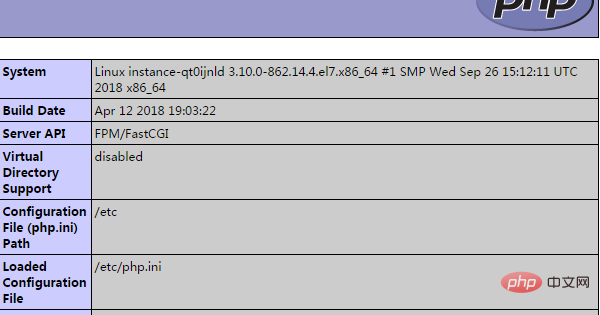How to compile and install php5.6.31
How to compile and install php5.6.31: 1. Add epel source and download php-5.6.31; 2. Unzip the installation package and install it; 3. Modify php-fpm.conf; 4. Start php -fpm; 5. Edit the nginx configuration file and restart the nginx service.

The operating environment of this article: CentOS 7 system, php5.6.31 version, DELL G3 computer
How to compile and install php5.6.31?
CentOS 7 Compile and install PHP5.6.31
There are already nginx and mysql on the server, so I decided to use PHP Nginx mysql Combination, I read a lot of information on the Internet. Since I don’t know much about Linux and PHP, I don’t know how PHP is related to nginx and mysql. I encountered various reasons (either PHP was installed incorrectly or the package was not installed). After spending a lot of time, I found out after the deployment that these three are installed separately (um~~can they be installed together). You only need to configure PHP after installation, and configure nginx (associated with PHP) to run directly. . As for mysql, as long as it is turned on and the connection database in the php project is configured, you can connect directly. So this article mainly focuses on the installation of php.
Regarding the installation of nginx and mysql, some development libraries for Linux need to be installed before starting the installation. I will not repeat them here. They are all in the reference link.
This article mainly refers to this link blog: https://www.cnblogs.com/flower-tree/p/7562101.html
php version: 5.6. 31
nginx version: 1.7.3
mysql version: 5.6.62
PHP installation configuration
nginx itself cannot handle PHP, it is just a WEB When the server receives the request, if it is a PHP request, it will be sent to the PHP interpreter for processing and the result will be returned to the client.
nginx generally sends the request to the fastcgi management process for processing. The fastcgi management process selects the cgi sub-process processing result and returns it to nginx.
What is PHP-FPM? PHP-FPM is a FASTCGI manager for PHP. It is only used for PHP. The new version has integrated php-fpm. php-fpm provides better php process management, can effectively control memory and processes, and can smoothly reload php configuration. . When configuring, you can enable php-fpm with the -enable-fpm parameter. Other parameters can be found here. As for what fastcgi is and its relationship with php-fpm, please refer to the link https://segmentfault.com/q/1010000000256516
Preparation before installation
Add epel source
rpm -Uvh http://dl.fedoraproject.org/pub/epel/6/x86_64/epel-release-6-8.noarch.rpm
Installation dependencies
yum install gcc bison bison-devel zlib-devel libmcrypt-devel mcrypt mhash-devel openssl-devel libxml2-devel libcurl-devel bzip2-devel readline-devel libedit-devel sqlite-develyum -y install gcc gcc-c++ glibcyum -y install libmcrypt-devel mhash-devel libxslt-devel \ libjpeg libjpeg-devel libpng libpng-devel freetype freetype-devel libxml2 libxml2-devel \ zlib zlib-devel glibc glibc-devel glib2 glib2-devel bzip2 bzip2-devel \ ncurses ncurses-devel curl curl-devel e2fsprogs e2fsprogs-devel \ krb5 krb5-devel libidn libidn-devel openssl openssl-devel
Downloadphp-5.6.31
1) Unzip the installation package to /usr/local/src
cd /usr/local/srctar -zvxf php-5.6.31.tar.gz
2) Enter the installation directory, Installation
cd php-5.6.31./configure --prefix=/usr/local/php --enable-fpm --with-mcrypt \--enable-mbstring --enable-pdo --with-curl --disable-debug --disable-rpath \--enable-inline-optimization --with-bz2 --with-zlib --enable-sockets \--enable-sysvsem --enable-sysvshm --enable-pcntl --enable-mbregex \--with-mhash --enable-zip --with-pcre-regex --with-mysql --with-mysqli \--with-gd --with-jpeg-dir --with-freetype-dir --enable-calendarmake && make install
CentOS 中下载php: wget http://php.net/get/php-5.6.30.tar.gz/from/this/mirror
The above completes the installation of php-fpm. The installation process will take some time.
About php configuration
1. Provide configuration files for php
cp php.ini-production /usr/local/php/etc/php.ini
Note: php.ini-production is still in /usr/local/src/php-5.6. 31 directory
2. Provide configuration file for php-fpm
cd /usr/local/phpcp etc/php-fpm.conf.default etc/php-fpm.conf vim etc/php-fpm.conf
Modify php-fpm.conf
user = www
group = www
If the www user does not exist, then add the www user first (default running user nobody)
groupadd www useradd -g www www
If this step is not configured, the browser will report an error when opening the php file
“The page you are looking for is temporarily unavailable. Please try again later”
Modify
pm.max_children = 150 pm.start_servers = 8 pm.min_spare_servers = 5 pm.max_spare_servers = 10 pid = /usr/local/php/var/run/php-fpm.pid
3. Start php-fpm
Execution
/usr/local/php/sbin/php-fpm
Use the following command to verify (if there are several php-fpm processes in the output of this command, it means the startup is successful):
ps aux | grep php-fpm
The result is as shown below:

3. Integration of nginx and php-fpm
Edit nginx configuration file
vim /usr/local/nginx/conf/nginx.conf
The initial content is as follows:
# nginx运行的用户名
user nginx;
# nginx启动进程,通常设置成和cpu的数量相等,这里为自动
worker_processes auto;
# errorlog文件位置
error_log /var/log/nginx/error.log;
# pid文件地址,记录了nginx的pid,方便进程管理
pid /run/nginx.pid;
# Load dynamic modules. See /usr/share/nginx/README.dynamic.
# 用来加载其他动态模块的配置
include /usr/share/nginx/modules/*.conf;
# 工作模式和连接数上限
events {
# 每个worker_processes的最大并发链接数
# 并发总数:worker_processes*worker_connections
worker_connections 1024;
}
# 与提供http服务相关的一些配置参数类似的还有mail
http {
# 设置日志的格式
log_format main '$remote_addr - $remote_user [$time_local] "$request" '
'$status $body_bytes_sent "$http_referer" '
'"$http_user_agent" "$http_x_forwarded_for"';
# access_log记录访问的用户、页面、浏览器、ip和其他的访问信息
access_log /var/log/nginx/access.log main;
# 这部分下面会单独解释
# 设置nginx是否使用sendfile函数输出文件
sendfile on;
# 数据包最大时发包(使用Nagle算法)
tcp_nopush on;
# 立刻发送数据包(禁用Nagle算法)
tcp_nodelay on;
# 链接超时时间
keepalive_timeout 65;
# 这个我也不清楚...
types_hash_max_size 2048;
# 引入文件扩展名与文件类型映射表
include /etc/nginx/mime.types;
# 默认文件类型
default_type application/octet-stream;
# Load modular configuration files from the /etc/nginx/conf.d directory.
# See http://nginx.org/en/docs/ngx_core_module.html#include
# for more information.
include /etc/nginx/conf.d/*.conf;
# http服务上支持若干虚拟主机。
# 每个虚拟主机一个对应的server配置项
# 配置项里面包含该虚拟主机相关的配置。
server {
# 端口
listen 80 default_server;
listen [::]:80 default_server;
# 访问的域名
server_name _;
# 默认网站根目录(www目录)
root /usr/share/nginx/html;
# Load configuration files for the default server block.
include /etc/nginx/default.d/*.conf;
# 默认请求
location / {
}
# 错误页(404)
error_page 404 /404.html;
location = /40x.html {
}
# 错误页(50X)
error_page 500 502 503 504 /50x.html;
location = /50x.html {
}
}
}We want to change the configuration Only the server part is needed. Enter vim editing mode, or use FlashFXP to share the configuration file to the desktop to make changes.
Only three changes are needed
server {
listen 80 default_server;
listen [::]:80 default_server;
# 这里改动了,也可以写你的域名,我用的是IP地址
server_name 192.168.0.222;
root /usr/share/nginx/html;
# Load configuration files for the default server block.
include /etc/nginx/default.d/*.conf;
location / {
# 这里改动了 定义首页索引文件的名称
index index.php index.html index.htm;
}
error_page 404 /404.html;
location = /40x.html {
}
error_page 500 502 503 504 /50x.html;
location = /50x.html {
}
# 这里新加的
# PHP 脚本请求全部转发到 FastCGI处理. 使用FastCGI协议默认配置.
# Fastcgi服务器和程序(PHP,Python)沟通的协议.
location ~ \.php$ {
# 设置监听端口
fastcgi_pass 127.0.0.1:9000;
# 设置脚本文件请求的路径
fastcgi_param SCRIPT_FILENAME $document_root$fastcgi_script_name;
# 引入fastcgi的配置文件
include fastcgi_params;
}
}Restart the nginx server
nginx -s reload
At this time, nginx and php have been jointly configured, but we do not know the actual configuration effect How about, at this time we can write a small test script to verify it.
As mentioned before, /usr/share/nginx/html is the root directory of Nginx website. We can create a php test script in this directory.
# phpinfo.php is the name of the file I want to create
vi /usr/share/nginx/html/phpinfo.php
After opening the editor, enter
<?php phpinfo();// 测试信息?>
After saving and exiting, enter http in the browser: //192.168.0.222/phpinfo.php, my IP here is 192.168.0.222, you can change it to your own. As shown in the figure, an interface similar to the following appears:

Nginx and php have been configured.
4. Reasons for errors during installation
When I installed according to the process, an error occurred: mcrypt.h not found. Please reinstall libmcrypt
It is because the php-mcrypt libmcrypt libmcrypt-devel packages are not installed, and the errors that occur are generally missing. Library or package, just install it.
Recommended learning: "PHP Video Tutorial"
The above is the detailed content of How to compile and install php5.6.31. For more information, please follow other related articles on the PHP Chinese website!

Hot AI Tools

Undresser.AI Undress
AI-powered app for creating realistic nude photos

AI Clothes Remover
Online AI tool for removing clothes from photos.

Undress AI Tool
Undress images for free

Clothoff.io
AI clothes remover

AI Hentai Generator
Generate AI Hentai for free.

Hot Article

Hot Tools

Notepad++7.3.1
Easy-to-use and free code editor

SublimeText3 Chinese version
Chinese version, very easy to use

Zend Studio 13.0.1
Powerful PHP integrated development environment

Dreamweaver CS6
Visual web development tools

SublimeText3 Mac version
God-level code editing software (SublimeText3)

Hot Topics
 1378
1378
 52
52
 PHP 8 JIT (Just-In-Time) Compilation: How it improves performance.
Mar 25, 2025 am 10:37 AM
PHP 8 JIT (Just-In-Time) Compilation: How it improves performance.
Mar 25, 2025 am 10:37 AM
PHP 8's JIT compilation enhances performance by compiling frequently executed code into machine code, benefiting applications with heavy computations and reducing execution times.
 PHP Secure File Uploads: Preventing file-related vulnerabilities.
Mar 26, 2025 pm 04:18 PM
PHP Secure File Uploads: Preventing file-related vulnerabilities.
Mar 26, 2025 pm 04:18 PM
The article discusses securing PHP file uploads to prevent vulnerabilities like code injection. It focuses on file type validation, secure storage, and error handling to enhance application security.
 OWASP Top 10 PHP: Describe and mitigate common vulnerabilities.
Mar 26, 2025 pm 04:13 PM
OWASP Top 10 PHP: Describe and mitigate common vulnerabilities.
Mar 26, 2025 pm 04:13 PM
The article discusses OWASP Top 10 vulnerabilities in PHP and mitigation strategies. Key issues include injection, broken authentication, and XSS, with recommended tools for monitoring and securing PHP applications.
 PHP Encryption: Symmetric vs. asymmetric encryption.
Mar 25, 2025 pm 03:12 PM
PHP Encryption: Symmetric vs. asymmetric encryption.
Mar 25, 2025 pm 03:12 PM
The article discusses symmetric and asymmetric encryption in PHP, comparing their suitability, performance, and security differences. Symmetric encryption is faster and suited for bulk data, while asymmetric is used for secure key exchange.
 PHP Authentication & Authorization: Secure implementation.
Mar 25, 2025 pm 03:06 PM
PHP Authentication & Authorization: Secure implementation.
Mar 25, 2025 pm 03:06 PM
The article discusses implementing robust authentication and authorization in PHP to prevent unauthorized access, detailing best practices and recommending security-enhancing tools.
 PHP API Rate Limiting: Implementation strategies.
Mar 26, 2025 pm 04:16 PM
PHP API Rate Limiting: Implementation strategies.
Mar 26, 2025 pm 04:16 PM
The article discusses strategies for implementing API rate limiting in PHP, including algorithms like Token Bucket and Leaky Bucket, and using libraries like symfony/rate-limiter. It also covers monitoring, dynamically adjusting rate limits, and hand
 What is the purpose of prepared statements in PHP?
Mar 20, 2025 pm 04:47 PM
What is the purpose of prepared statements in PHP?
Mar 20, 2025 pm 04:47 PM
Prepared statements in PHP enhance database security and efficiency by preventing SQL injection and improving query performance through compilation and reuse.Character count: 159
 How do you retrieve data from a database using PHP?
Mar 20, 2025 pm 04:57 PM
How do you retrieve data from a database using PHP?
Mar 20, 2025 pm 04:57 PM
Article discusses retrieving data from databases using PHP, covering steps, security measures, optimization techniques, and common errors with solutions.Character count: 159




